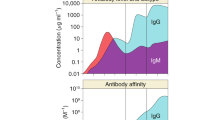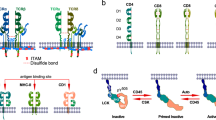Abstract
Antigen receptors on T and B cells function to transduce signals leading to a variety of biologic responses minimally including antigen receptor editing, apoptotic death, developmental progression, cell activation, proliferation and survival. The response to antigen depends upon antigen affinity and valence, involvement of coreceptors in signaling and differentiative stage of the responding cell. The requirement that these receptors integrate signals that drive an array of responses may explain their evolved structural complexity. Antigen receptors are composed of multiple subunits compartmentalized to provide antigen recognition and signal transduction function. In lieu of on-board enzymatic activity these receptors rely on associated Protein Tyrosine Kinases (PTKs) for their signaling function. By aggregating the receptors, and hence their appended PTKs, antigens induce PTK transphosphorylation, activating them to phosphorylate the receptor within conserved motifs termed Immunoreceptor Tyrosine-based Activation Motifs (ITAMs) found in transducer subunits. The tyrosyl phosphorylated ITAMs then interact with Src Homology 2 (SH2) domains within the PTKs leading to their further activation. As receptor phosphorylation is amplified, other effectors, such as Shc, dock by virtue of SH2 binding, and serve, in-turn, as substrates for these PTKs. This sequence of events not only provides a signal amplification mechanism by combining multiple consecutive steps with positive feedback, but also allows for signal diversification by differential recruitment of effectors that provide access to distinct parallel downstream signaling pathways. The subject of antigen receptor signaling has been recently reviewed in depth (; ). Here we discuss the biochemical basis of antigen receptor signal transduction, using the B cell receptor (BCR) as a paradigm, with specific emphasis on the involved PTKs. We review several specific mechanisms by which responses through these receptors are propagated and modified by accessory molecules, and discuss how signal amplification and diversification are achieved.
This is a preview of subscription content, access via your institution
Access options
Subscribe to this journal
Receive 50 print issues and online access
$259.00 per year
only $5.18 per issue
Buy this article
- Purchase on Springer Link
- Instant access to full article PDF
Prices may be subject to local taxes which are calculated during checkout
Similar content being viewed by others
Author information
Authors and Affiliations
Rights and permissions
About this article
Cite this article
Tamir, I., Cambier, J. Antigen receptor signaling: integration of protein tyrosine kinase functions. Oncogene 17, 1353–1364 (1998). https://doi.org/10.1038/sj.onc.1202187
Published:
Issue Date:
DOI: https://doi.org/10.1038/sj.onc.1202187
Keywords
This article is cited by
-
Comparative RNA-Seq transcriptome analyses reveal dynamic time-dependent effects of 56Fe, 16O, and 28Si irradiation on the induction of murine hepatocellular carcinoma
BMC Genomics (2020)
-
Signaling status of IgG B cell receptor (IgG BCR) is indicative for an activated state of circulating B cells in multiple myeloma
Annals of Hematology (2007)
-
Galectin-1 receptors in different cell types
Journal of Biomedical Science (2005)
-
The KSHV G protein-coupled receptor signals via multiple pathways to induce transcription factor activation in primary effusion lymphoma cells
Oncogene (2004)
-
The adaptor protein SLP-65 acts as a tumor suppressor that limits pre-B cell expansion
Nature Immunology (2003)



